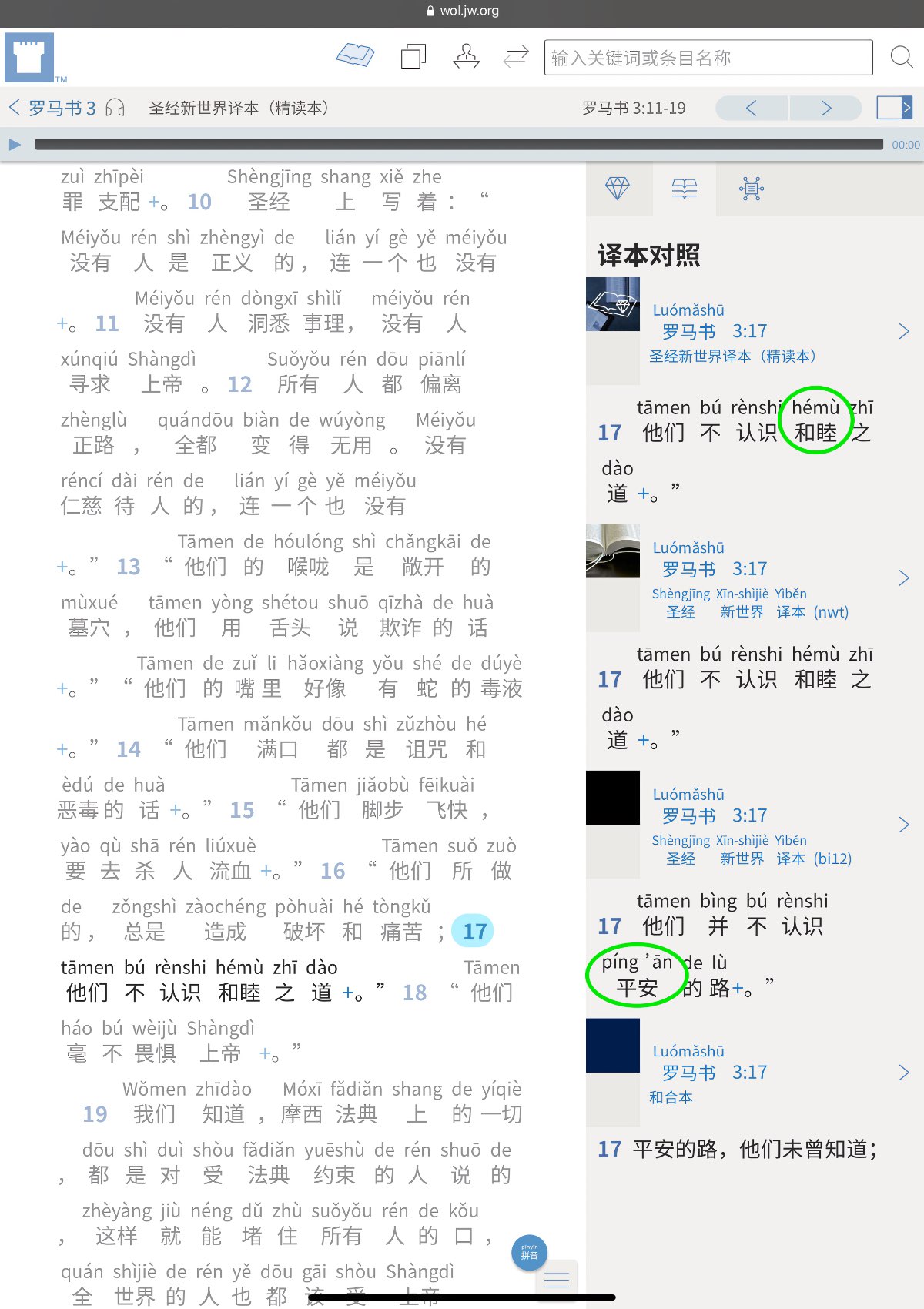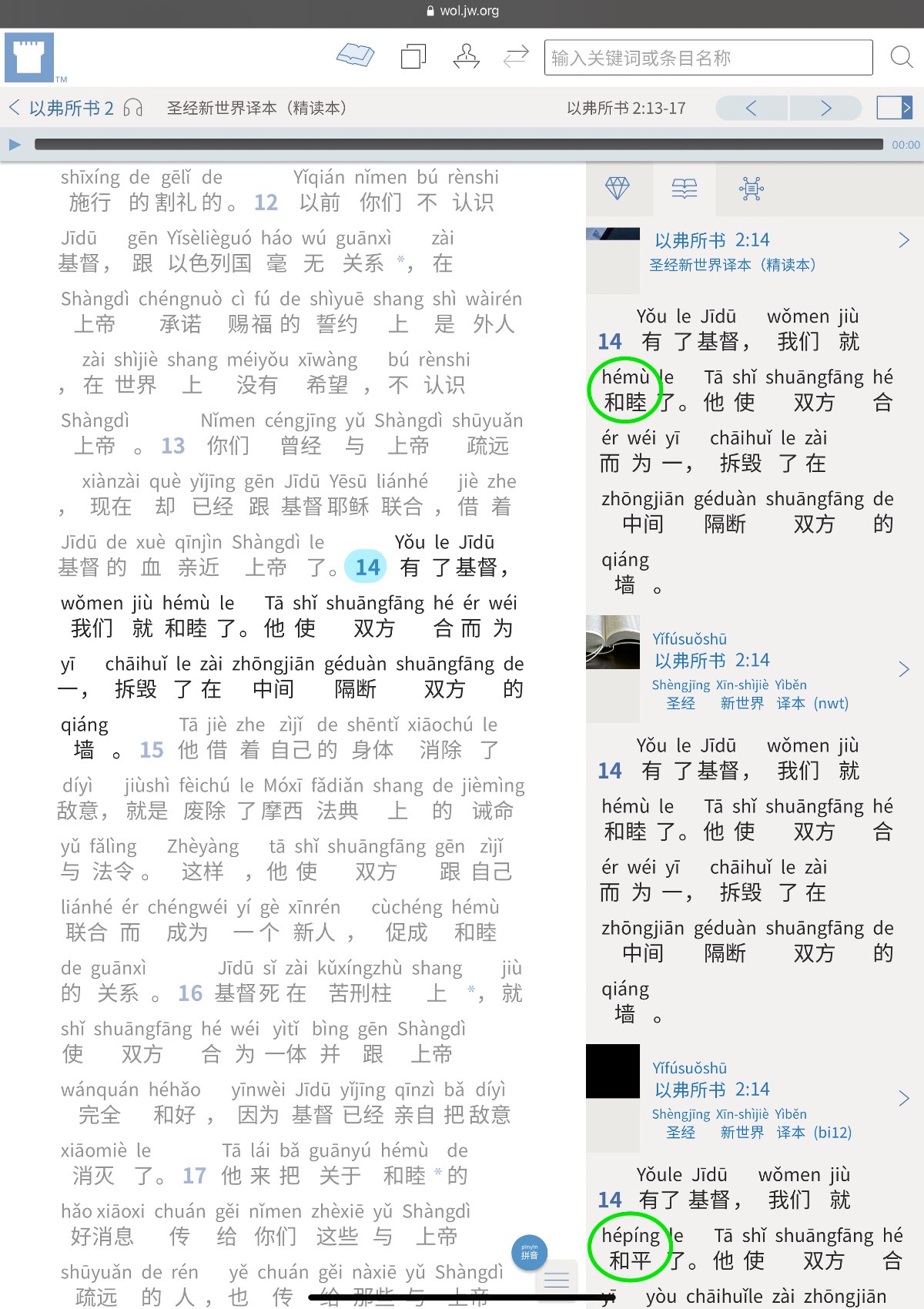hémù
({[is] harmonious}
和睦)
← Tap/click to show/hide the “flashcard”
Appendix A2 of the English New World Translation of the Holy Scriptures (Study Edition), entitled “Features of This Revision”, discusses vocabulary changes that have been made in the current revision, words that have been translated differently than before. As noted in various entries in the excellent resource Referenced Theo. Expressions (RTE), Appendix A2 of the current Mandarin version of the New World Translation Bible (nwtsty) correspondingly discusses words that have been translated differently in the current revision of the Mandarin NWT Bible, compared to how they had been translated before.
Since we base what we say in Jehovah’s service on his Word the Bible, the vocabulary used in it—and the way those vocabulary words are translated—should be reflected in how we speak in our ministry, at our meetings, etc. So, it is beneficial for us Mandarin field language-learners to be familiar with the latest thinking from the organization on how Bible terms should be translated into Mandarin.
Peace Is Multifaceted
One of the matters that Appendix A2 of the current Mandarin version of the New World Translation Bible (nwtsty) discusses is how several translations sometimes use the terms “píng’ān
(píng’·ān
{[is] flat, level, even → [[is] peaceful]} · {[is] safe, secure} (nwtsty-CHS Appx. A2 says this term mainly refers to things being smooth and stable, safe and secure, free of danger)
平安)” and “hépíng
(peace | {[is] peaceful} (nwtsty-CHS Appx. A2 says this term mainly refers to the absence of war or conflict)
和平)” in ways that don’t really fit the context, considering the relatively narrow meanings of these terms.
A previous MEotW post discussed why “ānníng
({being peaceful}; {being tranquil}
安宁
安寧)” was selected to be used in Galatians 5:22 in the current version of the Mandarin NWT Bible, when the previous major revision used “hépíng
(peace | {[is] peaceful} (nwtsty-CHS Appx. A2 says this term mainly refers to the absence of war or conflict)
和平)” there. Now, we will consider a couple of examples of how this week’s MEotW, “hémù
({[is] harmonious}
和睦)”, is used in the current version of the Mandarin NWT Bible.
Peace and Harmony in Romans 3:17
First, note how the Parallel Translations (Yìběn
(Yì·běn
Translated · {Roots → [Editions]} → [Translations]
译本
譯本)
Duìzhào
(Duì·zhào
{Facing → [Comparing]} · {Illuminating → [Comparing/Contrasting]} → [Comparing/Contrasting]
对照
對照) in Mandarin) feature of the Watchtower ONLINE LIBRARY shows us that in Romans 3:17, the current version of the Mandarin NWT Bible uses “hémù
({[is] harmonious}
和睦)” to replace “píng’ān
(píng’·ān
{[is] flat, level, even → [[is] peaceful]} · {[is] safe, secure} (nwtsty-CHS Appx. A2 says this term mainly refers to things being smooth and stable, safe and secure, free of danger)
平安)”:

Appendix A2 of the current Mandarin version of the New World Translation Bible (nwtsty) explains that “píng’ān
(píng’·ān
{[is] flat, level, even → [[is] peaceful]} · {[is] safe, secure} (nwtsty-CHS Appx. A2 says this term mainly refers to things being smooth and stable, safe and secure, free of danger)
平安)” mainly refers to things being smooth and stable, safe and secure, free of danger. In contrast, “hémù
({[is] harmonious}
和睦)” refers more specifically to being harmonious, making for peaceful relations with God and our fellow humans.
Peace and Harmony in Ephesians 2:14
Next, note that in Ephesians 2:14, the current version of the Mandarin NWT Bible uses “hémù
({[is] harmonious}
和睦)” to replace “hépíng
(peace | {[is] peaceful} (nwtsty-CHS Appx. A2 says this term mainly refers to the absence of war or conflict)
和平)”:

Appendix A2 of the current Mandarin version of the New World Translation Bible (nwtsty) explains that “hépíng
(peace | {[is] peaceful} (nwtsty-CHS Appx. A2 says this term mainly refers to the absence of war or conflict)
和平)” mainly refers to the absence of war or conflict. In contrast, “hémù
({[is] harmonious}
和睦)” is used here in a more positive and precise way to refer to the peaceful harmony and unity that the Christ makes possible for “shuāngfāng
(shuāng·fāng
(the) two · {directions → [parties]}
双方
雙方)”, “the two groups”, Jews and non-Jews.



